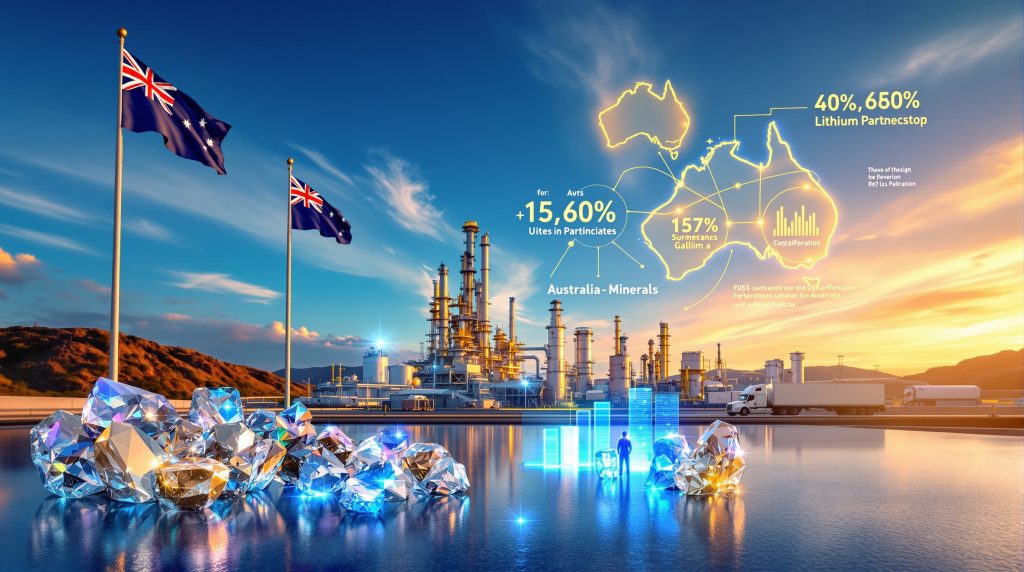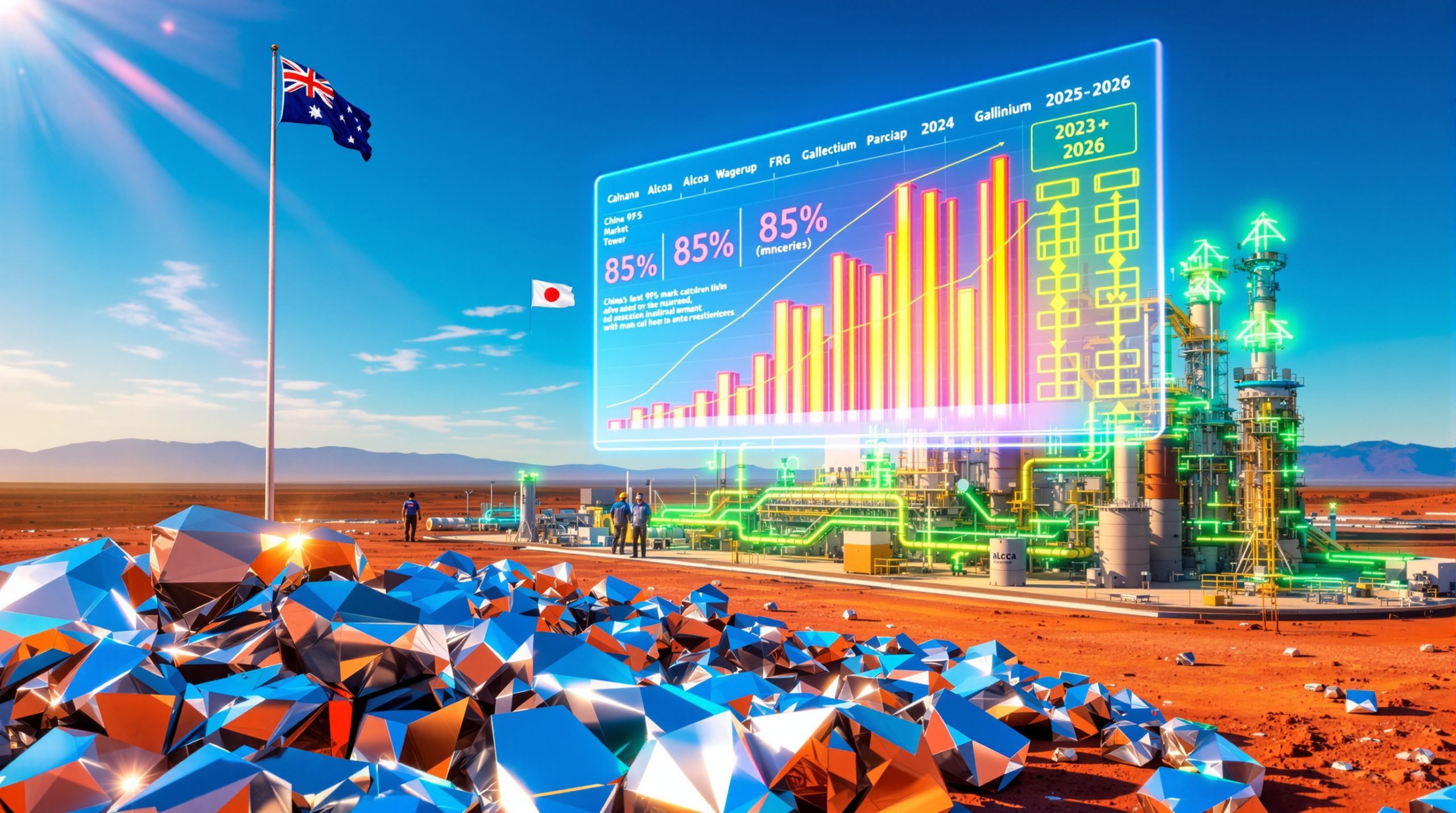Strategic Materials Under the Australia-US Critical Minerals Partnership
The Australia US critical minerals partnership encompasses a comprehensive range of essential elements that form the backbone of modern defense systems and advanced technologies. This bilateral framework prioritises materials where supply chain vulnerabilities pose significant national security risks, moving beyond traditional commodity trading to establish sovereign processing capabilities.
The partnership targets seven rare earth minerals that China restricted to US markets in April 2025, with expanded restrictions implemented in October 2025 specifically targeting the US defense sector. These materials are crucial for manufacturing everything from household appliances to sophisticated weapons systems, including F-35 fighter jets and precision-guided munitions.
Critical Material Categories
The alliance addresses multiple strategic mineral categories where China maintains dominant market control:
Rare Earth Elements: Of the 17 rare earth elements, seven are classified as heavy rare earths, which are vital for producing permanent magnets used extensively by the US military. These materials are essential for advanced defense systems and cannot be substituted with alternative materials.
Semiconductor Materials: The partnership includes gallium and germanium, both critical for microchip production and artificial intelligence applications. China restricted exports of these materials in December 2024 following the Biden administration's refusal to provide China access to high-grade AI chips.
Battery Materials: While China does not produce the most essential battery materials like lithium, cobalt, and graphite, it dominates the refining and processing of these materials to incomparable degrees, creating strategic vulnerabilities for renewable energy initiatives. These developments align with broader critical minerals energy security concerns across the region.
| Material Category | Primary Applications | Strategic Importance |
|---|---|---|
| Heavy Rare Earths | F-35 systems, permanent magnets | Defence-critical, no substitutes |
| Light Rare Earths | Electric vehicles, wind turbines | Clean energy transition |
| Gallium & Germanium | Advanced semiconductors, AI chips | Technology leadership |
| Battery Materials | Energy storage, electric vehicles | Energy independence |
Timeline of Escalating Mineral Tensions
The Australia US critical minerals partnership materialised following years of escalating trade tensions and strategic mineral weaponisation by China. The timing reflects urgent national security concerns rather than economic opportunism.
The most recent catalyst occurred on April 4, 2025, when Beijing imposed restrictions on seven rare earth mineral exports to America. This action came just two days after Trump's critical minerals order sent markets into turmoil, demonstrating China's willingness to weaponise mineral supplies during trade disputes.
Historical Pattern of Mineral Coercion
China's willingness to use minerals as geopolitical weapons has precedent spanning over a decade:
-
2010: China imposed an unofficial embargo on rare earth supplies to Japan during the Senkaku Islands territorial dispute, demonstrating how mineral dependencies could be leveraged for political pressure
-
2020-2023: China implemented an unofficial three-year trade ban on Australian imports during the pandemic, showing how economic relationships could be weaponised
-
December 2024: China restricted gallium and germanium exports following AI chip access disputes with the United States
-
April 2025: Seven rare earth minerals restricted to US markets immediately following Trump's tariff implementation
-
October 2025: Beijing expanded restrictions to include rare earths specifically used by the US defence sector, providing the final catalyst for the partnership agreement
According to Ian Verrender, ABC News Chief Business Correspondent, the mystery is not why America formed this historic partnership with Australia, but rather why it took so long given the obvious strategic advantages.
Australia's Strategic Advantages as a Partner Nation
Australia emerged as the ideal strategic partner due to unique geological endowments, established mining expertise, and democratic governance structures that ensure supply security. The continent hosts significant deposits of rare earths, lithium, and other critical materials within a stable regulatory environment.
Geological and Operational Advantages
Mount Weld Deposit: Located in Western Australia, this rare earth deposit sits in the plug of an ancient volcano and contains high-end rare earths. Operated by Lynas Rare Earths, it represents one of the world's most significant rare earth concentrations outside of China.
Processing Infrastructure: Australia already possesses sophisticated separation facilities through companies like Lynas Rare Earths, providing a foundation for expanded capabilities. Lynas operates both extraction facilities at Mount Weld and processing operations in Malaysia, with plans for US-based facilities.
Strategic Location: Australia's proximity to Asian manufacturing hubs combined with secure shipping lanes to North American markets creates logistical advantages for integrated supply chains. Furthermore, the Australia strategic reserve initiative strengthens these capabilities.
Proven Track Record
Australia's mining sector has demonstrated resilience against Chinese market manipulation tactics. Following the 2010 Japan-China rare earth crisis, Japanese officials backed Lynas Rare Earths with cheap loans to build processing facilities in Malaysia, establishing precedent for international cooperation on mineral security.
The partnership builds on existing US investments under the Inflation Reduction Act, including Lynas's $120 million contract with the US Department of Defense for a heavy rare earths separation facility in Texas.
Investment Allocation and Project Development
The Australia US critical minerals partnership involves joint investments spanning the entire supply chain from exploration through final processing. Each nation commits significant funding within accelerated timelines to address urgent supply security needs.
Major Project Commitments
Alcoa-Sojitz Gallium Recovery Facility: This trilateral project with Japan aims to supply 10% of global gallium demand through a facility in Western Australia. The project demonstrates how the partnership extends beyond bilateral cooperation to include allied nations facing similar supply vulnerabilities.
Japanese financing covers 50% of the Alcoa-Sojitz project costs, while Australian equity investment provides additional funding. This cost-sharing arrangement reflects the multilateral nature of supply chain security concerns.
Processing Capability Development: The investments prioritise processing capabilities rather than just raw material extraction. This strategic focus addresses the fundamental vulnerability where other nations may extract rare earths, but virtually all materials require Chinese refining facilities to become usable in manufacturing applications.
Timeline and Implementation
The partnership builds on earlier investments under the Biden administration's Inflation Reduction Act, providing continuity despite political transitions. Iluka Resources expects to complete the first heavy rare earths separation facility outside of China within 18 months, demonstrating the accelerated development timeline.
Processing facilities require 3-5 years to achieve full operational capacity, making immediate supply chain independence unrealistic. However, the partnership establishes the foundation for long-term strategic autonomy.
Japan's Critical Role in the Alliance Structure
Japan's involvement transforms the bilateral Australia US critical minerals partnership into a trilateral strategic alliance with established cooperation predating the formal framework. Japan's participation reflects its own vulnerability to supply disruptions and advanced manufacturing requirements.
Historical Motivation
Japan experienced China's rare earth embargo firsthand in 2010 when Beijing imposed an unofficial embargo following the Senkaku Islands dispute. This experience prompted Japanese officials to seek secure supply alternatives, leading to their backing of Lynas Rare Earths with cheap loans for Malaysian processing facilities.
Financial Participation
Japan's financing covers 50% of the Alcoa-Sojitz gallium project costs, demonstrating substantial commitment to supply chain diversification. This trilateral approach creates redundancy and resilience with processing capabilities distributed across three allied nations rather than concentrated in a single location.
The Japanese model provides a template for engaging other allied nations facing similar supply vulnerabilities, potentially expanding the partnership to include South Korea, Taiwan, and European Union members. Similar initiatives, including CRM facility developments in Europe, demonstrate the global nature of these concerns.
China's Comprehensive Market Dominance
China's control over critical minerals extends far beyond raw material production to encompass the entire processing ecosystem. This dominance represents decades of strategic investment beginning in the 1990s with explicit intentions to replicate OPEC's energy stranglehold through mineral control.
Scope of Control
According to John Coyne of the Australian Strategic Policy Institute, China currently controls production of 29 commodities, including 22 metals and seven industrial minerals. This dominance delivers power on both sides of the demand and supply equation.
China is the world's biggest producer of steel, dominates aluminium smelting and production, and has an outsized influence on copper markets. Commercial miners of many minerals have almost no option but to send their raw material to China for processing.
Market Control Mechanisms
Monopsony Power: Where China does not possess a near monopoly, it controls markets through monopsony conditions featuring one overbearingly important customer. While China does not produce the most essential battery materials, it buys, refines, and exports them to incomparable degrees.
Strategic Planning: China's dominance stems from deliberate strategic planning dating to 1992 when Deng Xiaoping expressed desires to mimic the Middle East's stranglehold on energy through rare earth control.
Integrated Ecosystem: China has cornered the entire rare earths ecosystem from mining through manufacturing, including near-monopoly production of permanent magnets essential for smartphones, robotics, and missiles.
National Security Implications and Defence Vulnerabilities
The partnership addresses critical vulnerabilities in defence supply chains where current Chinese processing dependence creates unacceptable risks for military readiness. Rare earths have become hugely strategic from a national security perspective, shifting priorities within Western nations in an increasingly hostile world.
Defence Applications
F-35 Fighter Jets: Heavy rare earths are vital for advanced systems in F-35 aircraft, with seven heavy rare earths classified as essential for permanent magnet production demanded by the US military.
Precision-Guided Munitions: Advanced weapons systems require specialised permanent magnets that depend on heavy rare earth processing, creating single points of failure in defence supply chains.
Strategic Stockpiling: The framework establishes sovereign capabilities for defence-critical materials, ensuring continued access during geopolitical tensions or diplomatic disputes.
Beyond immediate defence needs, the partnership secures supply chains for emerging technologies including quantum computing, advanced semiconductors, and next-generation energy systems that will define future military capabilities.
Market Pricing Manipulation and Competitive Response
The Australia US critical minerals partnership introduces competitive pressure into historically manipulated markets where China has demonstrated willingness to weaponise pricing control to eliminate competitors.
Evidence of Price Manipulation
Tom O'Leary, Managing Director of Iluka Resources, provides direct evidence of Chinese market manipulation: China manipulates the price of unprocessed rare earths to put rivals out of business through rigged pricing indices.
O'Leary specifically claims that prices published by the Asian Metal index represent the key source of pricing for producers but reflect artificial rather than genuine market conditions. Linking prices to the Asian Metal index only further entrenches China's market power.
Historical Manipulation Tactics
Supply Flooding: Following Japan's 2010 decision to back Lynas as an alternative supplier, Chinese supplies suddenly flooded the market, sending prices crashing. This coincided with community backlash in Malaysia, creating dual pressure that nearly caused Lynas to collapse.
Coordinated Campaigns: The combination of price manipulation and orchestrated opposition demonstrates China's comprehensive approach to maintaining market control beyond simple supply restrictions. These dynamics relate directly to how tariffs impact mining sector operations globally.
Long-term Market Evolution
Iluka Resources, developing the first heavy rare earths separation facility outside China within 18 months, has lost faith in global pricing to justify investment decisions. This reflects industry recognition that current pricing mechanisms serve Chinese strategic interests rather than genuine market dynamics.
Independent processing capabilities could establish more transparent pricing mechanisms, though initial price impacts may be limited until facilities achieve full operational capacity over 3-5 years.
Operational Challenges and Disruption Tactics
The partnership faces significant challenges beyond technical complexity, including coordinated disinformation campaigns and environmental opposition that could derail project development.
Chinese-Linked Disruption Operations
Texas Facility Campaign (2022): When Lynas won a $120 million US Department of Defense contract for a heavy rare earths separation facility in Texas, a sudden community backlash emerged driven by social media posts. Investigation revealed the campaign was run by a Chinese group called Dragonbridge using Facebook and Twitter accounts claiming the plant would cause irreversible environmental damage and radioactive contamination.
Malaysia Historical Pattern: Lynas had been subject to disinformation campaigns in Malaysia for years, but the Texas incident marked the first time with evidence of direct links between fake social media accounts spreading disinformation and political agendas.
Technical and Economic Barriers
Processing Complexity: Rare earths refining represents a difficult and dirty business requiring years to build into profitable enterprise. The complexity of separation chemistry creates high barriers to entry that favour established operations.
Investment Timeline: Building competitive capabilities demands not just financial investment but also knowledge transfer and workforce development spanning multiple years before achieving operational effectiveness.
Environmental Compliance: Massive government investment and lax environmental concerns helped China establish dominance, creating cost disadvantages for facilities operating under stricter environmental standards.
The partnership must navigate these challenges while maintaining public support and achieving operational timelines necessary for strategic effectiveness.
Integration with Broader Geopolitical Realignment
The Australia US critical minerals partnership represents part of a fundamental shift from globalised supply chains optimised for cost efficiency toward resilient networks prioritising security and reliability. This approach signals broader "friendshoring" trends among democratic nations.
Strategic Framework Evolution
The partnership complements existing security arrangements by creating overlapping frameworks that strengthen alliance structures. Economic security increasingly merges with traditional defence considerations, reflecting modern geopolitical realities where supply chain vulnerabilities can be weaponised.
Similar initiatives are emerging across allied nations, with countries seeking to reduce dependencies on potentially hostile nations for critical materials. The trend extends beyond minerals to semiconductors, pharmaceuticals, and other strategic sectors.
Continuity Across Political Transitions
The partnership builds on earlier investments under the Biden administration's Inflation Reduction Act while receiving support from the Trump administration, indicating bipartisan recognition of supply chain security importance. The US-Australia Framework signed by President Trump and Prime Minister Albanese demonstrates this continuity.
This continuity suggests the strategic imperatives transcend partisan politics, creating sustainable policy frameworks that can survive electoral transitions and maintain long-term effectiveness.
Success Metrics and Performance Indicators
Partnership effectiveness will be measured through concrete production targets, supply diversification achievements, and strategic stockpile development rather than abstract policy commitments.
Production Capacity Targets
Gallium Supply Goals: The Alcoa-Sojitz facility targets supplying 10% of global gallium demand, providing measurable contribution to reducing Chinese market control.
Processing Capability Development: Iluka Resources expects to complete the first heavy rare earths separation facility outside China within 18 months, establishing timeline benchmarks for additional projects.
Supply Chain Independence Measures
Diversification Metrics: Success requires reducing single-source dependency below critical thresholds while maintaining supply reliability for defence applications.
Strategic Reserve Development: Both nations aim to establish buffer stocks providing adequate supply security for defence-critical materials during potential disruptions.
Investment Deployment Speed: The partnership's credibility depends on rapid commitment and deployment of promised funding within established timelines.
The partnership represents a fundamental recognition that mineral supply chains have become weapons of economic warfare, requiring strategic responses that prioritise security over short-term cost optimisation.
The Australia US critical minerals partnership addresses decades of strategic vulnerability while establishing frameworks for long-term supply chain resilience. Success will ultimately be measured not just in production volumes or investment dollars, but in the degree to which democratic nations can secure the material foundations of technological and military superiority in an increasingly contested world.
Looking to Capitalise on Critical Minerals Investment Opportunities?
Discovery Alert's proprietary Discovery IQ model delivers real-time alerts on significant ASX mineral discoveries, instantly empowering subscribers to identify actionable opportunities in critical minerals and strategic materials ahead of the broader market. Understand why major mineral discoveries can lead to substantial returns by exploring Discovery Alert's dedicated discoveries page, showcasing historic examples of exceptional outcomes, then begin your 30-day free trial today to position yourself ahead of the market.




